#MajorScale
Text


© major scale
#ultkpopnetwork#mgroupsedit#idolsincedits#maleidolsedit#yoongi#suga#min yoongi#bangtan#bts#190504#tour:love/speak.yourself#yg:smile#yg.year:2019#yg.hair:silver#f:taken#majorscale
38 notes
·
View notes
Photo
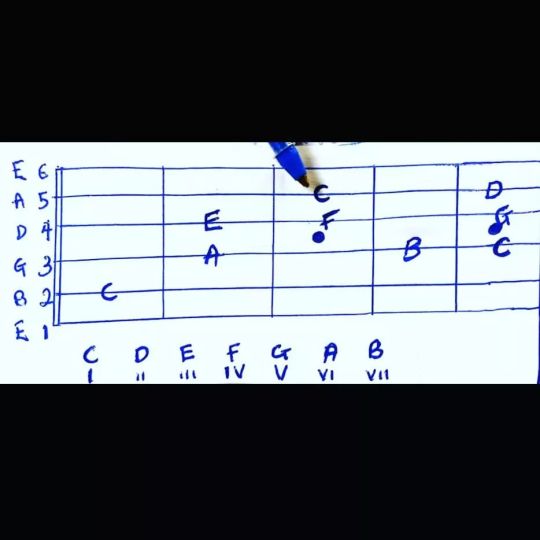
First Five Fret (FFF) C notes on the guitar 🎸 #musicalnotes #musicalkeys #musicalscales #chromatic #chromaticscale #chromaticscales #majorscale #majorscales #scales #musicscales #musicscale #music #musictheory #musicmemes #generalmusic #musicgallery #musicstuffs #music #guitarist #guitarchords #guitar #guitarplayer #guitarsolo #guitars #guitardaily #chords #guitarmusicchords (at Ejigbo, Lagos, Nigeria) https://www.instagram.com/p/CklkHNjMig7/?igshid=NGJjMDIxMWI=
#musicalnotes#musicalkeys#musicalscales#chromatic#chromaticscale#chromaticscales#majorscale#majorscales#scales#musicscales#musicscale#music#musictheory#musicmemes#generalmusic#musicgallery#musicstuffs#guitarist#guitarchords#guitar#guitarplayer#guitarsolo#guitars#guitardaily#chords#guitarmusicchords
0 notes
Video
youtube
Major Scale Chords in Sa Re Ga Ma: A Complete Guide
#youtube#majorscale chords saregama musictheory chordprogressions learnmusic musictutorial indianclassicalmusic music musiceducation piano
0 notes
Text
When the Holy Spirit hits you 🙌🏾
MARCEDRIC KIRBY FOUNDER CEO.
MARCEDRIC.KIRBY INC.
0 notes
Text
When you tell the organist to stop playing and he tries to sneak a run b...
Black Grandma's 👵🏿😃
0 notes
Video
instagram
You Gotta love some Major scales...🎶 Peavey HB USA LTD guitarra 🎸 going thro the Carvin Legacy3 + the Carvin VLD1 preamp pedal. . . . . . . . #homestudio #guitarshred #Majorscale #stevevai #guitarlick #guitar #electricguitar #guitarist #peaveyguitars #carvinamps #Carvinguitars #kieselguitars #guitarmania #superstrat #laneyamplifier #seymourduncan #batman #guitargram #lickwars #wowmusicians #solo_section #showguitars #riffwars #riffs4u #universityofrock #EVH #quiltedmaple #guitaristofinstagram #carvinlegacy #guitarlover @riffwars @romancewithjules (at Montreal, Quebec) https://www.instagram.com/p/B01DPrtHq59/?igshid=118rzqd8yaz3n
#homestudio#guitarshred#majorscale#stevevai#guitarlick#guitar#electricguitar#guitarist#peaveyguitars#carvinamps#carvinguitars#kieselguitars#guitarmania#superstrat#laneyamplifier#seymourduncan#batman#guitargram#lickwars#wowmusicians#solo_section#showguitars#riffwars#riffs4u#universityofrock#evh#quiltedmaple#guitaristofinstagram#carvinlegacy#guitarlover
2 notes
·
View notes
Text
Modal Sequencing -Two Note for All Instrumentalists
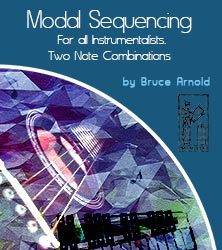
Two Note Modal Sequencing for All Instrumentalists
Modal Sequencing has long been a tool that musicians use to create great melodies and to improve their technical ability and aural comprehension. This series of courses covering Two, Three and Four Note Modal Sequencing provides a student with a comprehensive range of information on multiple levels to help understand this crucial aspect of music. Twenty Nine different modes are covered for a student to practice and master these important structures. Each course from Modal Sequencing shows how every melodic sequence could be changed to create not only other melodic but also rhythmic permutations, which gives an improviser many choices when applying these melodies. A PDF showing the modal sequence along with MP3s and Midifiles to hear each exercise have been included for all sequences. This greatly aids overall development because the student can check their accuracy when playing, singing or doing ear training exercises. Each course of the Modal Sequencing provides you with multiple exercises that you can do to improve your ear training skills. No matter how you use these exercises, by working with them you are using musically familiar patterns that will prepare you to improvise or compose over common melodies you encounter throughout your musical life.
There are many ways these modal sequences can help your musicianship. Below are just some of the uses you will find for these courses:
Developing new ideas for improvising whether you are a beginner or an advanced player
Developing a deeper knowledge of the scales included in this study.
Developing your technical skills. Modal Sequences are a "super" chops building machine.
Developing your ear training skills by singing and hearing various examples.
Developing the ability to both technically and aurally recognize common melodic movement.
Developing a melodic language that allows you to be more compositional in your improvisations
Developing a way to organize scalar ideas.
Developing a way to use these melodic patterns on multiple metric levels.
Please Note: If you are a guitarist we highly recommend that you also work with the Guitar Technique and Physiology Course so that you develop the modal sequences with the proper technique.
What's in each Course?
First, if you look further down on this page you will see examples from PDFs from the series so you can get a better idea of the layout of each course. Modal sequencing is playing through a scale with a pattern, such as playing a scale ascending and descending with thirds. This type of technique has been around since at least the 17th century. One listen to Johann Sebastian Bach's music will give you many examples of using modal sequencing as will listening to any Jazz, Blues or Heavy Metal player.
The Two, Three and Four Note Modal Sequencing course uses 29 scales which include the following:
Click on triangle to see lists of scales:
Major
Dorian
Phrygian
Lydian
Mixolydian
Aeolian
Locrian
Melodic Minor Ascending
Dorian b2
Lydian #5
Lydian b7
Mixolydian b6
Locrian Natural 2
Altered
Diminished
Symmetrical Diminished
Whole Tone
Harmonic Minor
Mixolydian b2b6
Major Pentatonic
Minor Pentatonic
Blues
Harmonic Major
Dorian b5
Phrygian b4
Lydian b3
Mixolydian b2
Lydian #2#5
Locrian bb7
This course concentrates on Two Note Melodic Sequences through 29 scales. There is a Bundle which contains all 29 scales or individual courses that contain only a subset of these scales. Below is a breakdown of the individual courses available for Two Note Modal Sequencing.
Two Note Modal Sequencing Bundle contains all 29 Scales
Two Note Modal Sequencing Group 1 contains the modes of Major
Two Note Modal Sequencing Group 2 contains the modes of Melodic Minor Ascending
Two Note Modal Sequencing Group 3 contains Symmetric, Major/Minor Pentatonic, Blues and Two modes of Harmonic Minor
Two Note Modal Sequencing Group 4 contains the modes of Harmonic Major
Videos Included!
Videos are included to help you apply modal sequencing and play them more musically.
Here is a list of videos include:
Click on triangle to see lists of videos:
Why You Should Work With 2 Note Sequences
Working with Two Note Modal Sequences
Working with Sixths Two Note Modal Sequences
Moving in Major Thirds Two Note Modal Sequences
Moving in Fourths Two Note Modal Sequences
Applying 2 Note Sequences to Ear Training.mp4
Different scales are used more in certain idioms. Here are some overall recommendations:
If you want to develop a well rounded music education and know 29 of the most used scales purchase the Bundle(s).
Traditional rock players should choose Groups 1 and 3
Jazz players should choose the Bundle(s).
Country music players should choose Groups 1 and 3.
Blues only players should choose Group 3.
Heavy Metal players should choose Groups 1, 2 and 3.
Country music players should choose Groups 1 and 3.
Quick Links to Each Course
Each course includes a massive amount of PDFs, MP3s and Midifiles so that you can customize your study. Purchase the Bundle(s) to save money or individual courses if you prefer a single download.
Two Note Sequencing Bundle
Two Note Sequencing Group 1
Two Note Sequencing Group 2
Two Note Sequencing Group 3
Two Note Sequencing Group 4
Two Note Modal Sequencing Bundle

Two Note Modal Sequencing Bundle is the most cost effective way to study!
The Bundle contains all 29 scales in the Two Note Series. It will allow a student to learn the most commonly used scales on their instrument plus it contains multiple ear training exercises to internalize the common melodies that are used in all types of music. If you want MEGACHOPS then look no further. These modal sequences will give you a massive quantity of awesome melodies and if you use the midifiles you can speed up your technique over time. These modal sequences are also great for exploring new improvisational ideas, so if you are tired of playing the same old thing, then this is the ticket to expanding your melodic palette!
Two Note Sequences Contain All Melodic Intervals Within an Octave
Remember that the two note modal sequences contain all melodic intervals so learning these sequences prepares you for any melody. In addition, the 29 scales provide you a lexicon of multiple melodic intervals within each sequence so you are covering a large number of the melodic shapes you may find in music.
Who should use the Modal Sequencingcourse?
The quick answer is EVERYONE! But seriously, these sequences help you develop new ideas for improvisation and they will show up in your playing fast. They built build mega-chops but they also make your improvisation more compositional because you can pick sequences that have more affinity with a particular song rather than playing the same type of melodies on all songs. Modal Sequences also help you learn your instrument better and help you recognize scale patterns quickly. Modal sequences sound good at a slow or fast tempo so you will get great use out of them in your improvisations.
Playing Modal Sequences at Different Metric Levels
Playing modal sequences at multiple metric levels not only makes every sequence you learn more useful, but by also changing the type of rhythm used you can further disguise the sequence. Our Two Note Modal Sequence course goes into great detail on these subjects.
Examples from the Bundle Course Package.
Below are some examples from the Bundle Course which contains all 29 modes. There are five different types of files and each is tailored for a specific student level. You will find even more examples if you scroll down into the individual course offerings.
Click on triangle to see a PDF example for first type of files.
The page below shows multiple one octave ascending and descending sequences for C Major. Each line contains a new sequence. This is a good place for an advanced student to start because the only the ascending part of the scale is shown and it is assumed that the descending part will be easy to calculate. All modal sequences are written out for every mode and every key.

There is no audio for these files
These type of files are meant for an advanced student who only needs to work with the ascending version of a sequence and can deduce the rest of the notes.
There are no audio files with these sequences.
Each sequence is presented in all 12 keys.
Click on triangle to see a PDF example for second type of files.
The page below shows multiple one octave ascending and descending sequences for a Eb Lydian b7 Scale. Each line contains a new sequence. This is a good place for an intermediate or advanced student that only needs to see the sequence written ascending. All modal sequences are written out for every mode and every key.

There is no audio for these files
These files present all the 2 Note Modal Sequences in one file which moves through all 12 keys.
There is no audio for these types of files.
Each sequence is played Ascending and Descending through one octave.
There are twelve two note sequences for each key. All 12 keys are included.
Click on triangle to see a PDF example for third type of files.
This Minor Pentatonic modal sequence is shown in triplets. This is one of many possible ways to change the rhythm of a modal sequence which can make it much more musical. This example shows a new modal sequence every two bars. The sequence moves two octaves ascending and descending. Again the presentation of the entire sequence is helpful when a student needs to see the entire sequence to play it correctly.

There is no audio for these types of files.
Playing two or four note modal sequences in triplets or other odd rhythm groupings is a great way to disguise a sequence and also give it more interest.
Because these modal sequences are played ascending and descending through two octaves they are good files for an intermediate level student to use to learn a sequence.
Click on triangle to see a PDF example for fourth type of files.
This example shows both permutations of a 2 note modal sequence in C Lydian#2#5 scale using 6ths and ascending and descending one octave.

There are 504 MP3s for this type of file. An example MP3 for the above score is found below:
There are also 504 midifiles for these PDFs so you can play them at any tempo.
You can use these études for ear training, sight reading, transcription or just to listen to ingrain the sound of the note in the key center. Remember, you can play these examples at any tempo, super slow or extremely fast, with the midifiles that accompany this course.
Click on triangle to see the last type of exercise which shows you just one sequence.
This example shows both permutations of a 2 note modal sequence in B Phrygian b4 scale using 3rds ascending and descending one octave.

There are 1008 MP3s for this type of file. Keep in mind that there are also midifiles for each example so you can play any exercise at any tempo.
You can use these études for ear training, sight reading, transcription or just to listen to ingrain the sound of the note in the key center. Remember, you can play these examples at any tempo... super slow or extremely fast with the midifiles that accompany this course.
Save money with the Two Note Modal Sequencing Bundle.
The bundle is a great way to save money. If you buy all four of the Two Note Modal Sequencing courses separately it will cost you 49.96. Get them now for the low price seen below.
Get the Two Note Modal Sequencing Bundle
ISBN: 978-1-59489-427-5 This course includes: 54 Page PDF, 6 Videos 15 minutes in total, 6,048 MP3s and 6,048 Midifiles
Add digital copy to cart - $39.99
Status: Currently Available, Digital book is available for immediate download!
Two Note Modal Sequencing Individual Courses
If you prefer to order one of the 4 groups that comprise the Bundle you will find information on each below:

Two Note Modal Sequencing Group 1
Each group consists of a number of related scales. Group 1 covers the modes of Major as seen below
Click on triangle to see lists of scales found in Two Note Modal Sequencing Group 1:
Major
Dorian
Phrygian
Lydian
Mixolydian
Aeolian
Locrian
The modal sequencing courses have been set up to work in more than one way. That is because there are different levels of students working with these courses. But also as you learn a scale and move it through all keys, you become more familiar with it so you don't need to see the complete sequence written out. Each of the Modal Sequences therefore has the sequences written out in various ways to accommodate these situations.
Keep these ideas in mind as you work through them:
Start the sequence at a tempo in which you are sure you are playing the correct notes.
Pay close attention to the physical way you are playing, to make sure it is the most ergonomic.
Say the note names or the degrees as you move through the scale until you feel it is second nature.
Try to sing the sequence over a drone or key center.
Use the "Long Line Rhythm" ideas as presented in the book to give a real boost to your speed.
Work with the ear training MP3s so that you can recognize the pattern when you hear it.
The “Two Note Modal Sequencing” score and audio content
Any seven note scale will have 6 intervals i.e. 2nds, 3rds, 4ths, 5ths, 6ths and 7ths and each interval has two permutations for a total of 12. Therefore each scale will be permutated through these 12 combination in all keys.
There are five different types of files found in this course. Two of these five types have audio in the form of MP3s and midifiles. Five different types of files are included because students require different types of files depending on their musicianship. As a student gets to know a scale or a sequence better they usually can deduce the rest of the sequence without seeing it totally written out. Keep in mind that you will find slight differences in how the modal sequence is written in different examples. This is done to make the sequence resolve on the beat.
Videos Included!
Videos are included to help you apply modal sequencing and play them more musically.
Here is a list of videos include:
Click on triangle to see lists of videos:
Why you should work with Two Note Modal Sequences
Working with two Note Modal Sequencing
Working with sixths Two Note Modal Sequencing
Moving in Thirds Two Note Modal Sequencing
Moving in Fourths Two Note Modal Sequencing
Using A Minor Third and Whole Step Three Note Modal Sequencing
Applying Modal Sequencing to Ear Training
A Look at the Type of Files found in this Course
There are many types of PDFs found in this course. This files allow to choose the best files based on your level.
Click on triangle to see a PDF example for first type of files.
The page below shows multiple one octave ascending and descending sequences for C Major. Each line contains a new sequence. This is a good place for a advanced student to start because the only the ascending part of the scale is shown and it is assumed that the descending part will be easy to calculate. All modal sequences are written out for every mode and every key.

There is no audio for these files
These type of files are meant for an advanced student who only needs to work with the ascending version of a sequence and can deduce the rest of the notes.
There are no audio files with these sequences.
Each sequence is presented in all 12 keys.
Click on triangle to see a PDF example for second type of files.
The page below shows multiple one octave ascending and descending sequences for C Major. Each line contains a new sequence. This is a good place for a beginner to start because the entire modal sequence is written out. All modal sequences are written out for every mode and every key.
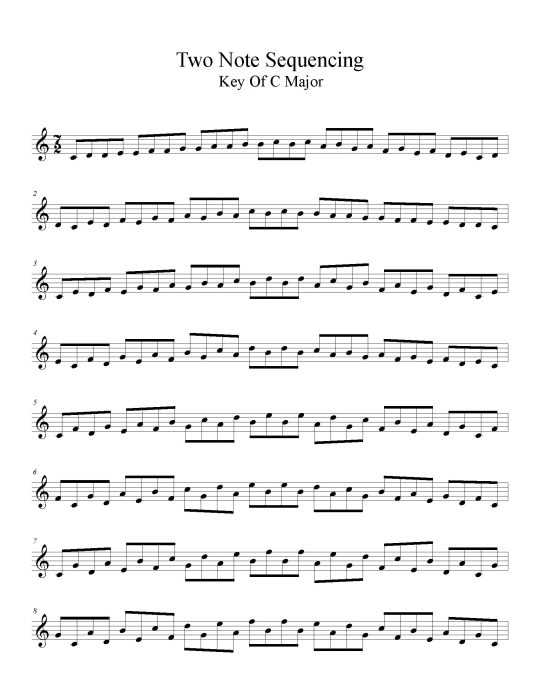
There is no audio for these files
These files present all the 2 Note Modal Sequences in one file which moves through all 12 keys.
There is no audio for these types of files.
Each sequence is played Ascending and Descending through one octave.
There are twelve two note sequences for each key. All 12 keys are included.
Click on triangle to see a PDF example for third type of files.
This Lydian modal sequence is shown in triplets. This is one of many possible ways to change the rhythm of a modal sequence which can make it much more musical. This example shows a new modal sequence every two bars. The sequence moves two octaves ascending and descending. Again the presentation of the entire sequence is helpful when a student needs to see the entire sequence to play it correctly.
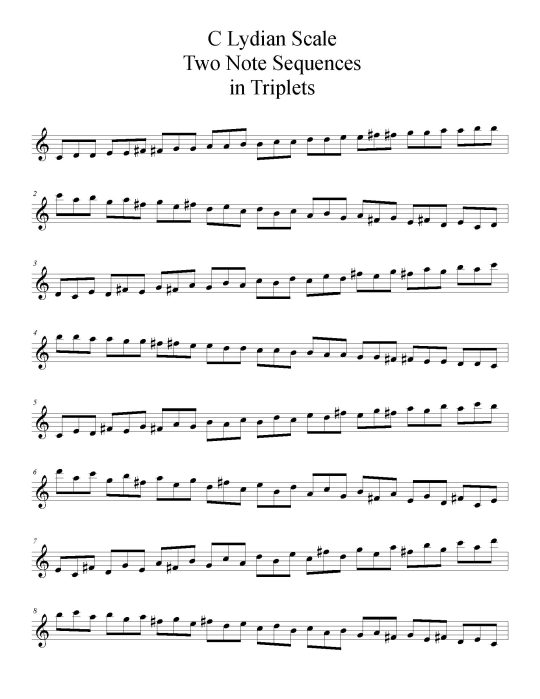
There is no audio for these types of files.
Playing two or four note modal sequences in triplets or other odd rhythm groupings is a great way to disguise a sequence and also give it more interest.
Because these modal sequences are played ascending and descending through two octaves they are good files for an intermediate level student to use to learn a sequence.
Click on triangle to see a PDF example for fourth type of files.
This example shows both permutations of a 2 note modal sequence in C Major scale using 2nds and ascending and descending one octave.

There are 504 MP3s for this type of file. An example MP3 for the above score is found below:
There are also 504 midifiles for these PDFs so you can play them at any tempo.
You can use these études for ear training, sight reading, transcription or just to listen to ingrain the sound of the note in the key center. Remember you can play these examples at any tempo, super slow or extremely fast, with the midifiles that accompany this course.
Click on triangle to see an example of the last type of modal sequence.
This example shows both permutations of a 2 note modal sequence in C Major scale using 2nds and ascending and descending one octave.

There are 1008 MP3s for this type of file. Keep in mind that there are also midifiles for each example so you can play any exercise at any tempo.
You can use these études for ear training, sight reading, transcription or just to listen to ingrain the sound of the note in the key center. Remember, you can play these examples at any tempo... super slow or extremely fast with the midifiles that accompany this course.
Get The Two Note Modal Sequence for all Instrumentalist Group 1 download today!
ISBN: 978-1-59489-415-2
54 Page PDF, 6 Videos 15 minutes in total, 1512 MP3s and 1512 Midifiles.
Add digital copy to cart - $14.99
Status: In stock, Digital book is available for immediate access.
Two Note Modal Sequencing Individual Courses

Two Note Modal Sequencing Group 2
Each group consists of a number of related scales. Group 2 covers the modes of Melodic Minor Ascending which as seen below
Click on triangle to see lists of scales found in Two Note Modal Sequencing Group 2:
Melodic Minor Ascending
Dorian b2
Lydian #5
Lydian b7
Mixolydian b6
Locrian Natural 2
Altered
The modal sequencing courses have been set up to work in more than one way. That is because there are different levels of students working with these courses. But also as you learn a scale and move it through all keys, you become more familiar with it so you don't need to see the complete sequence written out. Each of the Modal Sequences therefore has the sequences written out in various ways to accommodate these situations.
Keep these ideas in mind as you work through them:
Start the sequence at a tempo in which you are sure you are playing the correct notes.
Pay close attention to the physical way you are playing, to make sure it is the most ergonomic.
Say the note names or the degrees as you move through the scale until you feel it is second nature.
Try to sing the sequence over a drone or key center.
Use the "Long Line Rhythm" ideas as presented in the book to give a real boost to your speed.
Work with the ear training MP3s so that you can recognize the pattern when you hear it.
The “Two Note Modal Sequencing” score and audio content
Any seven note scale will have 6 intervals i.e. 2nds, 3rds, 4ths, 5ths, 6ths and 7ths and each interval has two permutations for a total of 12. Therefore each scale will be permutated through these 12 combination in all keys.
There are five different types of files found in this course. Two of these five types have audio in the form of MP3s and midifiles. Five different types of files are included because students require different types of files depending on their musicianship. As a student gets to know a scale or a sequence better they usually can deduce the rest of the sequence without seeing it totally written out. Keep in mind that you will find slight differences in how the modal sequence is written in different examples. This is done to make the sequence resolve on the beat.
Videos Included!
Videos are included to help you apply modal sequencing and play them more musically.
Here is a list of videos include:
Click on triangle to see lists of videos:
Why you should work with Two Note Modal Sequences
Working with two Note Modal Sequencing
Working with sixths Two Note Modal Sequencing
Moving in Thirds Two Note Modal Sequencing
Moving in Fourths Two Note Modal Sequencing
Using A Minor Third and Whole Step Three Note Modal Sequencing
Applying Modal Sequencing to Ear Training
A Look at the Type of Files found in this Course
There are many types of PDFs found in this course. This files allow to choose the best files based on your level.
Click on triangle to see a PDF example for first type of files.
The page below shows multiple one octave ascending and descending sequences for E Melodic Minor (Jazz Minor.) Each line contains a new sequence. This is a good place for a beginner to start because the entire modal sequence is written out. All modal sequences are written out for every mode and every key.

There is no audio for these files
These type of files are meant for an advanced student who only needs to work with the ascending version of a sequence and can deduce the rest of the notes.
There are no audio files with these sequences.
Each sequence is presented in all 12 keys.
Click on triangle to see a PDF example for second type of files.
The page below shows multiple one octave ascending and descending sequences for a Eb Lydian b7 Scale. Each line contains a new sequence. This is a good place for an intermediate or advanced student that only needs to see the sequence written ascending. All modal sequences are written out for every mode and every key.

There is no audio for these files
These files present all the 2 Note Modal Sequences in one file which moves through all 12 keys.
There is no audio for these types of files.
Each sequence is played Ascending and Descending through one octave.
There are twelve two note sequences for each key. All 12 keys are included.
Click on triangle to see a PDF example for third type of files.
This Altered Scale modal sequence is shown in triplets. This is one of many possible ways to change the rhythm of a modal sequence which can make it much more musical. This example shows a new modal sequence every two bars. The sequence moves two octaves ascending and descending. Again the presentation of the entire sequence is helpful when a student needs to see the entire sequence to play it correctly.

There is no audio for these types of files.
Playing two or four note modal sequences in triplets or other odd rhythm groupings is a great way to disguise a sequence and also give it more interest.
Because these modal sequences are played ascending and descending through two octaves they are good files for an intermediate level student to use to learn a sequence.
Click on triangle to see a PDF example for fourth type of files
This example shows both permutations of a 2 note modal sequence in C Dorian b2 scale using 5ths and ascending and descending one octave.

This example shows both permutations of a 2 note modal sequence in C C Dorian b2 scale using 2nds and ascending and descending one octave.
There are 504 MP3s for this type of file. An example MP3 for the above score is found below:
There are also 504 midifiles for these PDFs so you can play them at any tempo.
You can use these études for ear training, sight reading, transcription or just to listen to ingrain the sound of the note in the key center. Remember, you can play these examples at any tempo, super slow or extremely fast, with the midifiles that accompany this course.
Click on triangle to see the last type of exercise which shows you just one sequence.
This example shows both permutations of a 2 note modal sequence in Db Mixolydian scale using 2nds and ascending and descending one octave.

There are 1008 MP3s for this type of file. Keep in mind that there are also midifiles for each example so you can play any exercise at any tempo.
You can use these études for ear training, sight reading, transcription or just to listen to ingrain the sound of the note in the key center. Remember, you can play these examples at any tempo... super slow or extremely fast with the midifiles that accompany this course.
Get The Two Note Modal Sequence for all Instrumentalist Group 2 download today!
ISBN: 978-1-59489-416-9
54 Page PDF, 6 Videos 15 minutes in total, 1512 MP3s and 1512 Midifiles.
Add digital copy to cart - $14.99
Status: In stock, Digital book is available for immediate access.
Two Note Modal Sequencing Individual Courses

Two Note Modal Sequencing Group 3
Each group consists of a number of related scales. Group 3 covers two modes of Harmonic Minor and these scales: Two Symmetric, Two Pentatonic and the Blues Scales which as seen below
Click on triangle to see lists of scales found in Two Note Modal Sequencing Group 3:
Diminished
Symmetrical Diminished
Whole Tone
Harmonic Minor
Mixolydian b2b6
Major Pentatonic
Minor Pentatonic
Blues
The modal sequencing courses have been set up to work in more than one way. That is because there are different levels of students working with these courses. But also as you learn a scale and move it through all keys, you become more familiar with it so you don't need to see the complete sequence written out. Each of the Modal Sequences therefore has the sequences written out in various ways to accommodate these situations.
Keep these ideas in mind as you work through them:
Start the sequence at a tempo in which you are sure you are playing the correct notes.
Pay close attention to the physical way you are playing, to make sure it is the most ergonomic.
Say the note names or the degrees as you move through the scale until you feel it is second nature.
Try to sing the sequence over a drone or key center.
Use the "Long Line Rhythm" ideas as presented in the book to give a real boost to your speed.
Work with the ear training MP3s so that you can recognize the pattern when you hear it.
The “Two Note Modal Sequencing” score and audio content
Because this Group contains six, seven and eight note scales there will be different numbers of permutations for scales with different number of notes.
There are five different types of files found in this course. Two of these five types have audio in the form of MP3s and midifiles. Five different types of files are included because students require different types of files depending on their musicianship. As a student gets to know a scale or a sequence better they usually can deduce the rest of the sequence without seeing it totally written out. Keep in mind that you will find slight differences in how the modal sequence is written in different examples. This is done to make the sequence resolve on the beat.
Videos Included!
Videos are included to help you apply modal sequencing and play them more musically.
Here is a list of videos include:
Click on triangle to see lists of videos:
Why you should work with Two Note Modal Sequences
Working with two Note Modal Sequencing
Working with sixths Two Note Modal Sequencing
Moving in Thirds Two Note Modal Sequencing
Moving in Fourths Two Note Modal Sequencing
Using A Minor Third and Whole Step Three Note Modal Sequencing
Applying Modal Sequencing to Ear Training
A Look at the Type of Files found in this Course
There are many types of PDFs found in this course. This files allow to choose the best files based on your level.
Click on triangle to see a PDF example for first type of files.
The page below shows multiple one octave ascending and descending sequences for D Blues Scale. Each line contains a new sequence. This is a good place for an advanced student who doesn't need the whole sequence written out. All modal sequences are written out for every mode and every key.

There is no audio for these files
These type of files are meant for an advanced student who only needs to work with the ascending version of a sequence and can deduce the rest of the notes.
There are no audio files with these sequences.
Each sequence is presented in all 12 keys.
Click on triangle to see a PDF example for second type of files.
The page below shows multiple one octave ascending and descending sequences for Bb Major Pentatonic. Each line contains a new sequence. This is a good place for a beginner to start because the entire modal sequence is written out. All modal sequences are written out for every mode and every key.

There is no audio for these files
These files present all the 2 Note Modal Sequences in one file which moves through all 12 keys.
There is no audio for these types of files.
Each sequence is played Ascending and Descending through one octave.
There are twelve two note sequences for each key. All 12 keys are included.
Click on triangle to see a PDF example for third type of files.
This Minor Pentatonic modal sequence is shown in triplets. This is one of many possible ways to change the rhythm of a modal sequence which can make it much more musical. This example shows a new modal sequence every two bars. The sequence moves two octaves ascending and descending. Again the presentation of the entire sequence is helpful when a student needs to see the entire sequence to play it correctly.

There is no audio for these types of files.
Playing two or four note modal sequences in triplets or other odd rhythm groupings is a great way to disguise a sequence and also give it more interest.
Because these modal sequences are played ascending and descending through two octaves they are good files for an intermediate level student to use to learn a sequence.
Click on triangle to see a PDF example for fourth type of files.
This example shows both permutations of a 2 note modal sequence in C Harmonic Minor scale using 4ths and ascending and descending one octave.

There are 528 MP3s for this type of file. An example MP3 for the above score is found below:
There are also 504 midifiles for these PDFs so you can play them at any tempo.
You can use these études for ear training, sight reading, transcription or just to listen to ingrain the sound of the note in the key center. Remember you can play these examples at any tempo, super slow or extremely fast, with the midifiles that accompany this course.
Click on triangle to see the last type of modal sequence.
This example shows both permutations of a 2 note modal sequence in Bb Symmetrical Diminished scale using 1 and b5 and then ascending and descending one octave.

There are 1056 MP3s for this type of file. Keep in mind that there are also midifiles for each example so you can play any exercise at any tempo.
You can use these études for ear training, sight reading, transcription or just to listen to ingrain the sound of the note in the key center. Remember, you can play these examples at any tempo... super slow or extremely fast with the midifiles that accompany this course.
Get The Two Note Modal Sequence for all Instrumentalist Group 3 download today!
ISBN: 978-1-59489-417-6
54 Page PDF, 6 Videos 15 minutes in total, 1584 MP3s and 1584 Midifiles.
Add digital copy to cart - $14.99
Status: In stock, Digital book is available for immediate access.
Two Note Modal Sequencing Individual Courses
If you prefer to order one of the 4 groups that comprise the Bundle book you will find information on each below:
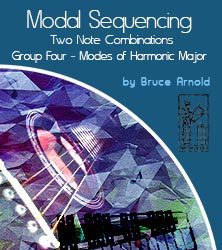
Two Note Modal Sequencing Group 4
Each group consists of a number of related scales. Group 4 covers the modes of Harmonic Major which as seen below
Click on triangle to see lists of scales found in Two Note Modal Sequencing Group 4:
Harmonic Major
Dorian b5
Phrygian b4
Lydian b3
Mixolydian b2
Lydian #2#5
Locrian bb7
The modal sequencing courses have been set up to work in more than one way. That is because there are different levels of students working with these courses. But also as you learn a scale and move it through all keys, you become more familiar with it so you don't need to see the complete sequence written out. Each of the Modal Sequences therefore has the sequences written out in various ways to accommodate these situations.
Keep these ideas in mind as you work through them:
Start the sequence at a tempo in which you are sure you are playing the correct notes.
Pay close attention to the physical way you are playing, to make sure it is the most ergonomic.
Say the note names or the degrees as you move through the scale until you feel it is second nature.
Try to sing the sequence over a drone or key center.
Use the "Long Line Rhythm" ideas as presented in the book to give a real boost to your speed.
Work with the ear training MP3s so that you can recognize the pattern when you hear it.
The “Two Note Modal Sequencing” score and audio content
Any seven note scale will have 6 intervals i.e. 2nds, 3rds, 4ths, 5ths, 6ths and 7ths and each interval has two permutations for a total of 12. Therefore each scale will be permutated through these 12 combination in all keys.
There are five different types of files found in this course. Two of these five types have audio in the form of MP3s and midifiles. Five different types of files are included because students require different types of files depending on their musicianship. As a student gets to know a scale or a sequence better they usually can deduce the rest of the sequence without seeing it totally written out. Keep in mind that you will find slight differences in how the modal sequence is written in different examples. This is done to make the sequence resolve on the beat.
Videos Included!
Videos are included to help you apply modal sequencing and play them more musically.
Here is a list of videos include:
Click on triangle to see lists of videos:
Why you should work with Two Note Modal Sequences
Working with two Note Modal Sequencing
Working with sixths Two Note Modal Sequencing
Moving in Thirds Two Note Modal Sequencing
Moving in Fourths Two Note Modal Sequencing
Using A Minor Third and Whole Step Three Note Modal Sequencing
Applying Modal Sequencing to Ear Training
A Look at the Type of Files found in this Course
There are many types of PDFs found in this course. This files allow to choose the best files based on your level.
Click on triangle to see a PDF example for first type of files.
The page below shows multiple one octave ascending and descending sequences for C Harmonic Major. Each line contains a new sequence. This is a good place for an advanced student who doesn't need the entire modal sequence is written out. All modal sequences are written out for every mode and every key.

There is no audio for these files
These type of files are meant for an advanced student who only needs to work with the ascending version of a sequence and can deduce the rest of the notes.
There are no audio files with these sequences.
Each sequence is presented in all 12 keys.
Click on triangle to see a PDF example for second type of files.
The page below shows multiple one octave ascending and descending sequences for C Mixolydian b2. Each line contains a new sequence. This is a good place for a beginner to start because the entire modal sequence is written out. All modal sequences are written out for every mode and every key.

There is no audio for these files
These files present all the 2 Note Modal Sequences in one file which moves through all 12 keys.
There is no audio for these types of files.
Each sequence is played Ascending and Descending through one octave.
There are twelve two note sequences for each key. All 12 keys are included.
Click on triangle to see a PDF example for third type of files.
This Bb Lydian b3 modal sequence is shown in triplets. This is one of many possible ways to change the rhythm of a modal sequence which can make it much more musical. This example shows a new modal sequence every two bars. The sequence moves two octaves ascending and descending. Again the presentation of the entire sequence is helpful when a student needs to see the entire sequence to play it correctly.
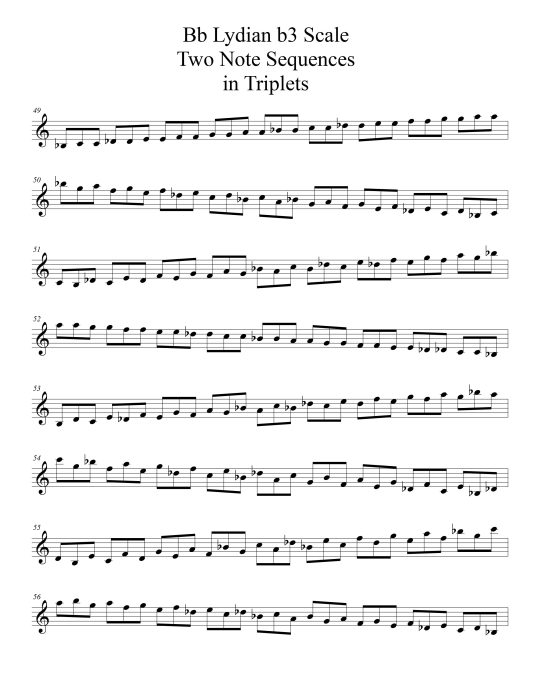
There is no audio for these types of files.
Playing two or four note modal sequences in triplets or other odd rhythm groupings is a great way to disguise a sequence and also give it more interest.
Because these modal sequences are played ascending and descending through two octaves they are good files for an intermediate level student to use to learn a sequence.
Click on triangle to see a PDF example for fourth type of files.
This example shows both permutations of a 2 note modal sequence in C Lydian#2#5 scale using 6ths and ascending and descending one octave.

There are 504 MP3s for this type of file. An example MP3 for the above score is found below:
There are also 504 midifiles for these PDFs so you can play them at any tempo.
You can use these études for ear training, sight reading, transcription or just to listen to ingrain the sound of the note in the key center. Remember, you can play these examples at any tempo, super slow or extremely fast, with the midifiles that accompany this course.
Click on triangle to see the last type of modal sequence.
This example shows both permutations of a 2 note modal sequence in B Phrygian b4 scale using 3rds ascending and descending one octave.

There are 1008 MP3s for this type of file. Keep in mind that there are also midifiles for each example so you can play any exercise at any tempo.
You can use these études for ear training, sight reading, transcription or just to listen to ingrain the sound of the note in the key center. Remember, you can play these examples at any tempo... super slow or extremely fast with the midifiles that accompany this course.
Get The Two Note Modal Sequence for all Instrumentalist Group 4 download today!
ISBN: 978-1-59489-418-3
54 Page PDF, 6 Videos 15 minutes in total, 1512 MP3s and 1512 Midifiles.
Add digital copy to cart - $14.99
Status: In stock, Digital book is available for immediate access.
Reviews
What people are saying:
I contacted Bruce because I was trying to get my improvisation going with the modes of major. He recommended doing some modal sequencing to give me ideas because honestly I had very few. I'm not much of a reader but by playing through a few of these sequences I quickly got some new ideas. I also purchased his "One Minute Lessons" which really helped me with adding in articulation to these various melodies. W. Volheim
I'm a sax player and really have to thank you for these modal sequences. Especially the Harmonic Major ones. It's really hard to find any good information on them on the internet and your information on how to apply them to diminished chords really showed me that these are important scales. I also like the various types of files found in the course. I needed everything spelled out for me when I started but now I just look at the ascending part of the scale and can figure out the rest. I highly recommend this course it's one of a kind!J. Anders
Being a singer it's always hard to find good courses that help me learn improvisation. This course with its MP3 was exactly what I needed. Having audio files really helped me hear these melodies and Mr. Arnold was correct I started just naturally singing these melodies quickly in my improvisations. I would recommend this course wholeheartedly. G. Butterfield
I'm not one for books that much but I do like this course. I can just spend a few minutes looking at a sequence then I've got it and can start sticking it into my improv. I also found the information in the book useful. It was direct and to the point. S. Takeshi
Have a story or a review you want to submit. We would love to hear from you please send us an email.
Read the full article
#modalsequencing#blues#diminishedscale#melodiclines#majorscale#longlinerhythm#alteredscale#Bluesscale#DorianScale#PhrygianScale#LydianScale#MixolydianScale#AeolianScale#LocrianScale#MelodicMinorAscendingScale#Dorianb2Scale#Lydian5Scale#Lydianb7Scale#Mixolydianb6Scale#LocrianNatural2Scale#SymmetricalDiminishedScale#WholeToneScale#HarmonicMinorScale#Mixolydianb2b6Scale#MajorPentatonicScale#MinorPentatonicScale#HarmonicMajorScale#Dorianb5Scale#Phrygianb4Scale#Lydianb3Scale
1 note
·
View note
Video
youtube
How To Play The C Major Chord 11 Different Ways On Guitar - @EricBlackmo...
#chord#Cchord#howtoplayaCchord#guitarchords#chordtabs#guitarlesson#guitartutorial#ericblackmonguitar#ericblackmonmusic#ericblackmon#howtoplayguitar#acousticguitar#chordshapes#am#majorscale
0 notes
Photo

© MAJOR SCALE
821 notes
·
View notes
Photo

Work at night...#work#workinprogress#musician#triads#majorscale#scalamaggiore#Guitar#chitarristiitaliani#domenicasera https://www.instagram.com/p/CKce_6uHa6G/?igshid=zm38j4x604zc
#work#workinprogress#musician#triads#majorscale#scalamaggiore#guitar#chitarristiitaliani#domenicasera
0 notes
Photo

Guitar Scale D# Major . . Guitar🎸 scale D# Major . . Here another major scale of guitar you can play this from different strings🎸.... . . stay at home and stay safe and learn at home 🎸🎼🎧 . . #samvetgurukul #guitar🎸 D# #majorscale #musicmood #learningthroughplay #easypatterns #guitarscale #moody #happyhour #musica #happy #samvetgurukul #guitarplayers #guitare #guitarlesson #guitardaily #guitartalk #guitarriff #guitarpick #guitarists #guitarrist #guitarvideo #guitarplaying #guitarristas #guitarlesson #easylikesundaymorning (at Samvet Gurukul) https://www.instagram.com/p/CGc-izxD1jl/?igshid=1fxp3naezp1pu
#samvetgurukul#guitar🎸#majorscale#musicmood#learningthroughplay#easypatterns#guitarscale#moody#happyhour#musica#happy#guitarplayers#guitare#guitarlesson#guitardaily#guitartalk#guitarriff#guitarpick#guitarists#guitarrist#guitarvideo#guitarplaying#guitarristas#easylikesundaymorning
0 notes
Text


© mscale
#ultkpopnetwork#mgroupsedit#idolsincedits#maleidolsedit#yoongi#suga#min yoongi#bangtan#bts#200221#ev:todayshow#fs:taken#yoongi in ; 2020#yoongi's hair color palette – blonde w/ highlights#majorscale
44 notes
·
View notes
Photo

Playing from the neck, there are three open strings D, G and B Play with ease by using your Ring 💍 finger on 3rd Fret, Middle finger on 2nd Fret and index finger on 1st Fret all through the strings on the neck pattern Then use index finger on 2nd Fret, middle finger on 3rd Fret, Ring finger on 4th Fret and baby finger on 5th Fret all through the strings for the second pattern... @davido @olamide @symplysimi @symplysimi #davido #simi #olamidebaddo #musicalnotes #musicalkeys #musicalscales #chromatic #chromaticscale #chromaticscales #majorscale #majorscales #scales #musicscales #musicscale #music #musictheory #musicmemes #generalmusic #musicgallery #musicstuffs #music #guitarist #guitarchords #guitar #guitarplayer #guitarsolo #guitars #guitardaily #chords #guitarmusicchords (at Ejigbo, Lagos, Nigeria) https://www.instagram.com/p/CkieYQqDFUB/?igshid=NGJjMDIxMWI=
#davido#simi#olamidebaddo#musicalnotes#musicalkeys#musicalscales#chromatic#chromaticscale#chromaticscales#majorscale#majorscales#scales#musicscales#musicscale#music#musictheory#musicmemes#generalmusic#musicgallery#musicstuffs#guitarist#guitarchords#guitar#guitarplayer#guitarsolo#guitars#guitardaily#chords#guitarmusicchords
0 notes
Photo

Today's conference was a success. At The Virtual Choir Conference. The goal of the class was to help us learn the art of composition using musical notes or tonic solfa and preserving the tunes on a music sheet Tonic solfa notation is a system used in reading music which involves the use of solfa notes. Solfa notation came into use in the 19th century. And it involves the use of seven consonants, small letters of the alphabets known as d, r, m, f, s, l, t, d. while the first note is been repeated. A music sheet generally consists of music staffs on which we can place our song represented in notes. But we considered a quick way of achieving the same thing if we are to use a musical sheet using solfa notation. And then we composed too. Many thanks to our great teacher. Mr Ademola Emmanuel. God bless you sir. Host: Yours truly @begetmusic #musictraining #musicworkshop #musicians #musiciansworkshop #musicisessential #musicessenyials #musicfundamentals #majorscale #artistes #singers #vocalists #musical #thevirtualchoirconference #thevirtualchoirconferencewithbegetmusic #begetmusic #theminstrelsoldier (at Virtual Conference) https://www.instagram.com/p/B-rp8pZpDOn/?igshid=1uert32y2gply
#musictraining#musicworkshop#musicians#musiciansworkshop#musicisessential#musicessenyials#musicfundamentals#majorscale#artistes#singers#vocalists#musical#thevirtualchoirconference#thevirtualchoirconferencewithbegetmusic#begetmusic#theminstrelsoldier
0 notes
Photo

New episode in line now! https://youtu.be/AFLjjXica3o. #majorscale #musictheory #happyvssad #majorminor nurtureversusnature https://www.instagram.com/p/B-Ir9F3F1ad/?igshid=53a5t4e40996
0 notes
Photo


💕💓💕💖💗💓💝💕💖💓💘💕💗💖💗💓💕💖💓💗💖💗💖💓💕💗💖💗💖💘💗💖
19 notes
·
View notes